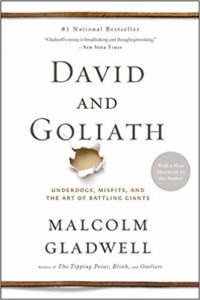
Book Review with synopsis. David and Goliath: Underdogs, Misfits, and the Art of Battling Giants by Malcom Gladwell. This book cuts across a broad range of topics, yet does a good job of weaving them together with the common theme question of “what is really an advantage and what is really a disadvantage?”. Gladwell challenges the common wisdom of what constitutes each. I found this book to be valuable (and would recommend it) because it offers numerous pieces of life wisdom that are not necessarily superficially obvious. If you think you know something about what preconditions lead to success and which lead to failure, read this book, it may make your reconsider what you think you “know”.
As someone working with a small start up company indirectly taking on large corporate giants like Procter & Gamble, the metaphor of David vs. Goliath is an appealing one. However, as Malcolm Gladwell points out in this book, it is not always so clear cut as to what constitutes an “advantage” and what constitutes a “disadvantage,” and who might actually hold the upper hand in any given situation.
There are several valuable pieces of wisdom found in this book. One of my favorites is, don’t play by the rules that others assume you will play by. Instead, reset the rules to your own advantage. Goliath assumed David would confront him in close combat, an assumption that proved fatal. David played by his own set of rules – battling Goliath from a distance – and thus stacking the odds in his favor.
Another favorite piece of wisdom I took away from this book is, what at first may seem to be a disadvantage, can ultimately be turned into an advantage. This could be thought of as a sort of strategic jujitsu – if you can re-frame things the right way. For example, inexperience in a field can allow someone to approach it from a fresh perspective and question fundamental assumptions that are made by more or less everyone who is experienced in that field. Gladwell uses an example of a basketball coach who had zero prior coaching experience, but who was effectively able to rethink strategy. He structured his game plan using the letter of the rules, and employed a “full court press”, a technique which almost no other coaches were utilizing. This led his inexperienced team to national success.
Gladwell uses interesting concepts, such as school class size, to broaden your thinking. Throughout education systems a great deal of emphasis is placed on class size, and the assumption is always that large class sizes are problematic, and that smaller class sizes are better for students. However Gladwell presents compelling evidence that there is an optimum school class size, and that optimum is not always the smaller class size. This involves several social psychology phenomenon that you will enjoy reading about in the book. While I was reading this section I couldn’t help thinking back to optimization functions in calculus. More specifically, if you graph test scores as a function of class size, you get an “inverted U curve”. Too small of a class produces poorer results, just as too large of a class size will. There are apparently a lot of teachers who are aware of this “real world wisdom”, yet it goes against what we commonly hear from the media and education academics.
Gladwell also answers some interesting questions such as “Is it better to be a mediocre student in a top tier university, or is it better to be a top tier student in a mediocre university?” The case studies and data presented by Gladwell make for enjoyable reading with answers that are not necessarily intuitive.
Two topics that I found particularly fascinating were case studies of people whose parents died during their childhood, and children who start off with certain learning disabilities. Gladwell presents evidence that these two scenarios follow the pattern of “that which does not kill you makes you stronger” (sort of). What I mean by that is, for children who lose their parents early in life, that event either destroys them and destines them for failure, or it forces them to grow tremendously strong and sends them on a trajectory for great success. Apparently the data shows that for people who lose their parents early in life, few of them end up with “middle of the road” lives.
Similarly, while learning disabilities may create substantial lifelong challenges for perhaps a majority of people who have them, there are some people for whom such disabilities may actually drive them to success. How does that happen? The key seems to be the degree to which individuals develop compensating mechanisms for their limitations. Some people are able to develop “super powered” compensatory mechanisms in other skill areas that allow them to succeed and more than make up for the learning shortcomings they may have.
Gladwell seems to get a bit side tracked when he writes about the origin and consequences of the well known “three strikes” law for criminal penalties. While this chapter doesn’t quite fit with the rest, it does provide a good example of how it is very easy to create systems with counterproductive unintended consequences.
Gladwell also delves into some examples of politics and war, including the civil war in Northern Ireland, and the German bombings of London during World War II. The former topic (Northern Ireland) raises the point that if an “authority” is not perceived as democratic, predictable, and just/fair, then that authority will be perceived as illegitimate, and will be disobeyed. The latter topic (the London bombings) raises and answers the interesting psychological question of “do near death experiences make people more afraid of dying, or do they make people more fearless about death?” I will not spoil the answer, and will let you find out for yourselves.
Finally, in the modern struggle between the favorite and the underdog, public perception can be as important or more important than anything else. Gladwell uses the example of the civil rights movement to make his case for this.
If strategic thinking is part of your life, and you could benefit from some concepts that allow you to re-frame the “rules” to your own advantage, then I would certainly recommend this book. Alternately, if you would just like a well written, interesting read, that utilizes good story telling to take you to places you might not otherwise visit, then I would also recommend it. Either way it will certainly make you think differently about the world around you, from basketball, to politics, to education, to matters of life and death.
For Health,
Rob
Nature's Complement is a participant in the Amazon Services LLC Associates Program, an affiliate advertising program. If you purchase products on Amazon through any of our affiliate links, we get a small percentage of the transaction, at no extra cost to you. We spend a lot of time writing the articles on this site, and all this information is provided free of charge. When you use our affiliate links, you support the writing you enjoy without necessarily buying our products. (However we would appreciate if you would do that too!) Thank you for helping to support our work, however you choose to do so.
These statements have not been evaluated by the Food and Drug Administration. This information and/or products are not intended to diagnose, treat, cure or prevent any disease.


